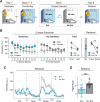Behavioral and brain mechanisms mediating conditioned flight behavior in rats
- PMID: 33859260
- PMCID: PMC8050069
- DOI: 10.1038/s41598-021-87559-3
Behavioral and brain mechanisms mediating conditioned flight behavior in rats
Abstract
Environmental contexts can inform animals of potential threats, though it is currently unknown how context biases the selection of defensive behavior. Here we investigated context-dependent flight responses with a Pavlovian serial-compound stimulus (SCS) paradigm that evokes freeze-to-flight transitions. Similar to previous work in mice, we show that male and female rats display context-dependent flight-like behavior in the SCS paradigm. Flight behavior was dependent on contextual fear insofar as it was only evoked in a shock-associated context and was reduced in the conditioning context after context extinction. Flight behavior was only expressed to white noise regardless of temporal order within the compound. Nonetheless, rats that received unpaired SCS trials did not show flight-like behavior to the SCS, indicating it is associative. Finally, we show that pharmacological inactivation of two brain regions critical to the expression of contextual fear, the central nucleus of the amygdala (CeA) and bed nucleus of the stria terminalis (BNST), attenuates both contextual fear and flight responses. All of these effects were similar in male and female rats. This work demonstrates that contextual fear can summate with cued and innate fear to drive a high fear state and transition from post-encounter to circa-strike defensive modes.
Conflict of interest statement
The authors declare no competing interests.
Figures






References
Publication types
MeSH terms
Substances
Grants and funding
LinkOut - more resources
Full Text Sources
Other Literature Sources

